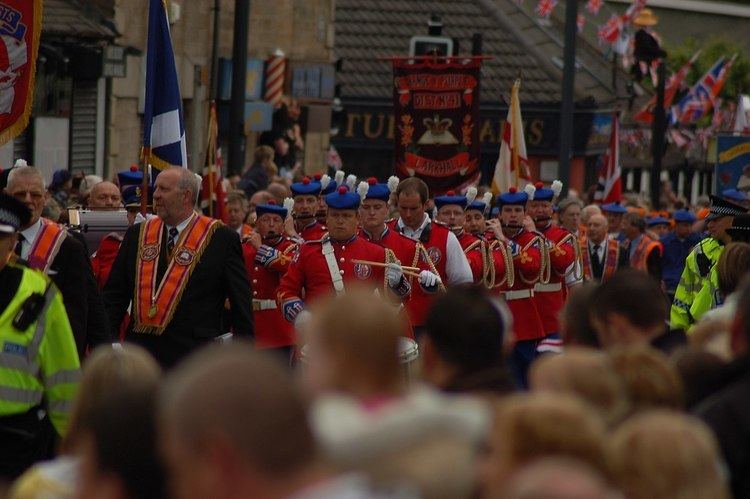Formation 1798 | Legal status Religious brotherhood Membership 50,000 | |
 | ||
Headquarters Olympia House,13 Olympia Street,BridgetonGlasgow, ScotlandG40 3TA | ||
The Grand Orange Lodge of Scotland, or Loyal Orange Institution of Scotland, is the branch of the Orange Order in Scotland. It is a Protestant fraternity that defends/promotes Protestantism, Britishness, and the continued unity of the United Kingdom (i.e. unionism). It also campaigns against Scottish independence and was an official participant in the 2014 independence referendum. Its headquarters are in Bridgeton, Glasgow and it claims about 50,000 members, the vast majority of whom are working-class Protestants from the Scottish Lowlands.
Contents
The Orange Order was formed in Ulster in 1795 by Ulster Protestants, many of whom had Scottish roots. It was brought to Scotland in 1798 by soldiers returning from service in Ulster, and its membership was soon swelled by large numbers of Ulster Protestant immigrants. As such, the Scottish branch has strong links with Northern Ireland and Ulster unionism/loyalism.
The Order is best known for its yearly marches, the biggest of which are held on and around 12 July ('The Twelfth').
Origins
In the early 17th century, following the Nine Years' War, the Irish province of Ulster was colonized by Protestant settlers from Britain. There was another wave of Scottish migration to Ulster during the Scottish famine of the 1690s.
In the 'Glorious Revolution' of 1688, Catholic king James II was overthrown and replaced by the Dutch-born Protestant king William of Orange. This led to war in Ireland and rebellion in the Scottish Highlands. The mainly-Protestant armies of William (Williamites) defeated the mainly-Catholic armies of James (Jacobites).
The Orange Order was founded in Ulster in 1795 – during a period of Protestant-Catholic sectarian conflict – as a brotherhood sworn to defend the Protestant British monarchy. Its name is a tribute to William of Orange.
In 1798, Protestant British soldiers from Scotland were sent to Ireland to help suppress an Irish republican rebellion. These soldiers fought alongside Orange militiamen and, when they returned to Scotland, they founded Scotland's first Orange lodges. The Scottish Orange Order grew swiftly in the early 1800s, when there was an influx of working-class Ulster Protestant immigrants into the Scottish Lowlands. Many of these immigrants saw themselves as returning to the land of their forefathers.
There was also a wave of Irish Catholic immigration to the Lowlands in this period, especially during the Great Famine. To gain an upper hand in their new home, and to differentiate themselves from the Irish Catholics, Irish Protestants showed their loyalty to 'king and country' through the medium of the Orange Order.
The first Orange march in Scotland was held in Glasgow on 12 July (The Twelfth) 1821. It was accompanied by sectarian unrest between Protestants and Catholics. Since then, Orange marches in Scotland have been associated with public disorder and sectarian violence, which led to them being banned on several occasions.
Scottish Orange Order leaders forged informal alliances with "anti-Popery" Tories to oppose Catholic emancipation in 1829 and Parliamentary Reform in 1831.
Structure
The Grand Orange Lodge of Scotland is made up of four County Grand Lodges: Ayrshire-Renfrewshire and Argyll, Central Scotland, East of Scotland and Glasgow. From these County Grand Lodges Orangemen and Orangewomen are elected to the organisation's governing body.
Opposition to Scottish independence
The Orange Order has long been opposed to Scotland becoming independent from the United Kingdom.
On 24 March 2007 about 12,000 Orangemen from Scotland and other parts of the UK marched in Edinburgh to celebrate the 300th anniversary of the Acts of Union 1707. This culminated in a rally where its leaders warned members of the danger of the Scottish National Party and Scottish independence. The Grand Master of the Grand Orange Lodge of Scotland, Ian Wilson, said that "the Union has been good for Scotland and will continue to be good for Scotland".
The Orange Order, after decades of decline in Scotland, made a short-lived recovery in its membership between 2006 and 2009. In October 2009 the Orange Order again declared its strong opposition to the Scottish National Party and Scottish independence. Traditionally supportive of the Scottish Conservative Party, as well as the Scottish Unionist Party, which was founded by members of the Orange Order who opposed the Anglo-Irish Agreement, in 2009 the Orange Order in Scotland vowed to support unionism even if that meant turning their coats and aiding their political opponents the Scottish Labour Party in elections.
In 2012, as a response to the upcoming Scottish independence referendum, 2014 the Orange Order of Scotland set up its own group called British Together to campaign for a No vote, stating that; "It will come as no surprise to most that the Orange Order in Scotland is fervently opposed to the break-up of the United Kingdom. Ever since the first Orange lodges were constituted in Scotland in 1797, we have been committed to a United Kingdom, headed by a constitutional Monarchy". In 2014 it then officially registered as a "permitted participant" in the Scottish referendum campaign. It held a major anti-independence rally in Edinburgh on 13 September 2014, five days before the vote.
